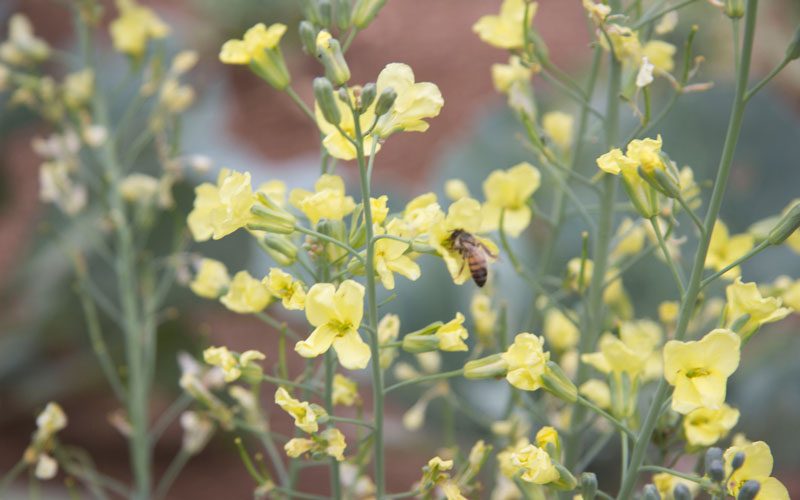
Chick-a-Bee Gardens in Gilbert uses bees to pollinate its vegetable crops.
(Photo by Kaitlyn Thompson/Cronkite News)
Honey bees play an imperative role in the feeding the country as they pollinate about a third of all food consumed in United States, according to the American Beekeeping Federation.
Many people run screaming at the buzz of bees, but the insects’ death could create a big impact on the agricultural system.
The number of honey bees colonies has steadily declined from about 5 million in the 1940s to 2.5 million today, according to data from the U.S. Department of Agriculture. Experts say of the main causes for this decline is colony collapse disorder, where an entire bee colony drops dead, leaving behind empty hives.
To better understand the resilience of the bee colonies that survive through tough living conditions, Arizona State University’s School of Life Sciences researchers studied honey bee larvae. They published their findings in the Journal of Experimental Biology at the end of March.
“Combined stressors such parasites, pathogens, pesticides, environmental changes cause the decline of honey bee population,” said Ying Wang, an assistant research professor at ASU and lead author of the study. “Malnutrition is one of the fundamental factors interacting with others contribute to the (colony collapse disorder).”
Wang and University Provost Emeritus Robert E. Page, Jr., co author of the study, found that bees faced with short-term starvation when young adapt better to starvation as adults.
“When bees are challenged nutritionally by being denied food, even for a short period of time, it changes the fundamental physiology that affects them when they are adults with respect to the production and storage of lipids that are very important to their ability to survive during periods of decreased food available,” Page said.
Wang said this study gives beekeepers and entomologists a strategy to solve the problem of bee decline. He said by starving bees during their development, they become more resistant to tough living conditions and colony collapse disorder.
“The problem we have today with the health of bees, a large part of that problem, is nutrition,” Page said. “By not being nutritionally healthy, it makes them more susceptible for disease. They don’t live as long in the wintertime when they used to live a long time because there aren’t new bees being produced in colonies.”
Entomologists and beekeepers are already working to make a change for bees. Derek Abello, a beekeeper and bee remover from Abello Bees in Phoenix, said that it’s up to the beekeepers to provide the right habitat for bees.
“Beekeepers need to keep bees as close to their natural state as possible,” Abello said. “This means pesticide free, antibiotic free, small cell honey combs like found in nature and sugar free. Let bees consume their own honey, not feed them artificial sugars or sweeteners.”
Page said honey bees need a variety of plants and flowers to forage to stay healthy. Bees that don’t get an assortment of pollen miss out on amino acids they need, Paige said.
“That’s a consequence of our agricultural practices, our urban practices,” Page said. “We can do better by providing a better habitat, and beekeepers can do better by providing bees with a better habitat to forage in.”
Bella Donna, beekeeper and holistic health care specialist for BHappy BHealthy in Lake Montezuma, said the best thing for bees would be to keep them away from humans and agricultural areas. Allowing them to live naturally would provide a wider range of plants for bees to pollinate.
Honey bees are not a lost cause, Wang said. There is still hope for their colonies to grow, and he’s already seeing an improvement.
“The effort of the scientists and beekeepers to understand bees and save bees have resulted in significant enhancement of honey bee health by improving bee management practices,” Wang said.